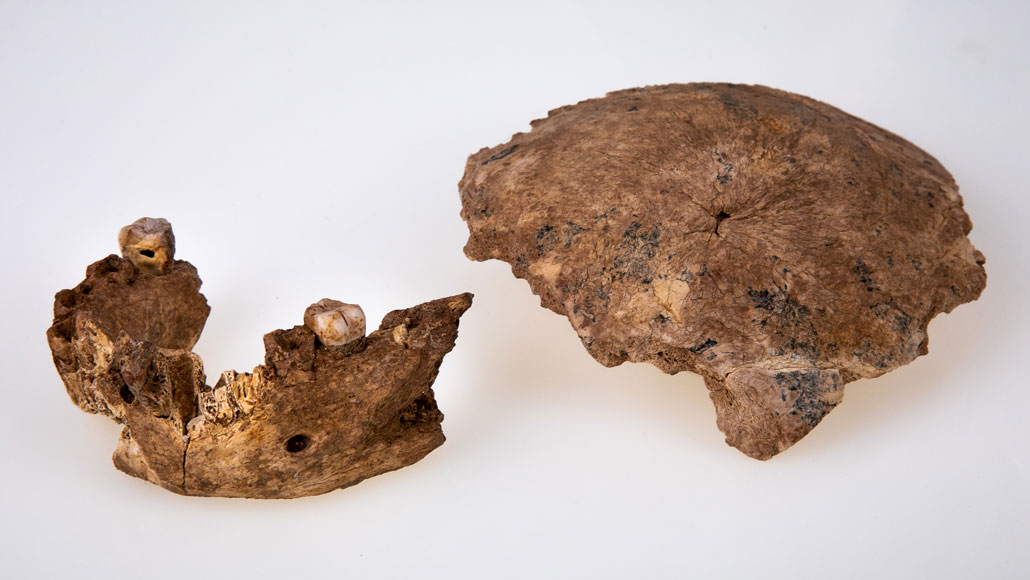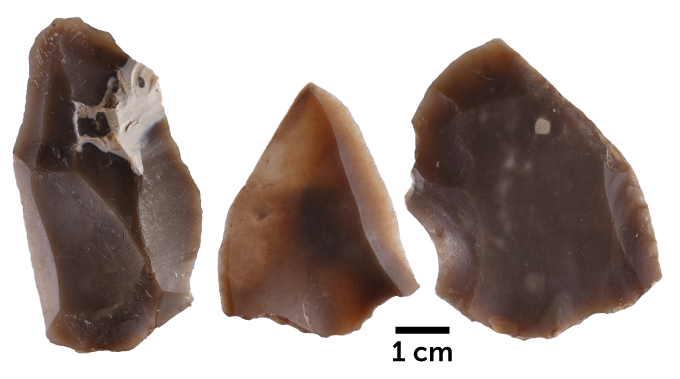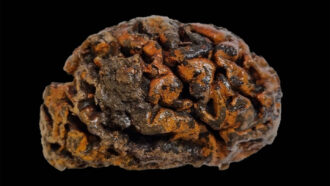Fossils unearthed in Israel reveal possible new human ancestor
They come from a previously unknown Stone Age group and complicate the human family tree

These parts of a jaw (left) and a skull (right), come from Israel’s Nesher Ramla site. The fossils represent an ancient hominid population. It contributed to the evolution of European Neandertals and possibly some ancient Homo groups in East Asia, researchers say.
Avi Levin and Ilan Theiler/Sackler Faculty of Medicine/Tel Aviv Univ.
By Bruce Bower
Excavations in an Israeli sinkhole have turned up a previously unknown Stone Age group of hominids. Its members contributed to the evolution of our genus, Homo. Remains at the new site, known as Nesher Ramla, come from 140,000 to 120,000 years ago. This hominid joins Neandertals and Denisovans as a third Euro-Asian population that belong to our genus. Over time, researchers say, they culturally mingled with — and possibly interbred with — our species, Homo sapiens.
Hominid fossils also have been found in three Israeli caves. Some date to as early as 420,000 years ago. They likely come from an ancient population of the hominid group whose remains have just turned up at Nesher Ramla. That’s the conclusion of a new study. Paleoanthropologist Israel Hershkovitz led that study. He works at Tel Aviv University in Israel.
His team hasn’t assigned a species name to the newfound hominids. The researchers simply refer to them as Nesher Ramla Homo. These folk lived in the Middle Pleistocene. It ran from about 789,000 to 130,000 years ago. Back then, interbreeding and cultural mixing took place among Homo groups. This happened so much, the team notes, that it prevented the evolution of a distinct Nesher Ramla species.
Two studies in the June 25 Science describe the new fossils. Hershkovitz led one team that described the hominid remains. Archaeologist Yossi Zaidner of the Hebrew University of Jerusalem led a second team. It dated rock tools found at the site.
The new fossils further complicate the human family tree. That tree has grown more complex in the past six years or so. Its branches hold several newly identified hominids. They include H. naledi from South Africa and the proposed H. luzonensis from the Philippines.
“Nesher Ramla Homo was one of the last survivors of an ancient group of [hominids] that contributed to the evolution of European Neandertals and East Asian Homo populations,” Hershkovitz says.
Lots of cultural mixing
Work at Nesher Ramla uncovered five pieces of a skull. They come from the braincase. (As the term implies, this bone encased the brain.) A nearly complete lower jaw also turned up. It still held a lone, molar tooth. These fossils in some ways look like Neandertals. In other ways, they better resemble remains of a pre-Neandertal species. It was called Homo heidelbergensis. Scientists think those individuals occupied parts of Africa, Europe and possibly East Asia as early as 700,000 years ago.
Some Homo fossils from sites in China also show a mix of traits that resemble features of the Nesher Ramla fossils, Hershkovitz says. It may be, he says, that ancient Homo groups with roots at this site may have reached East Asia and mated with hominids there.
But Nesher Ramla folk didn’t have to go that far to interact with other hominids. Stone tools at the Nesher Ramla site match those of about the same age made by nearby H. sapiens. Nesher Ramla Homo and early members of our species must have exchanged skills on how to make stone tools, Hershkovitz concludes. These folk also may have interbred. DNA from the new fossils might have confirmed that. For now, however, efforts to get DNA from the Nesher Ramla fossils have failed.
Along with the new fossils, Hershkovitz’s team dug up some 6,000 stone artifacts. They also found several thousand bones. Those came from gazelles, horses, tortoises and more. Some of those bones showed stone-tool marks. That would suggest the animals had been butchered for meat.

John Hawks at the University of Wisconsin–Madison did not take part in the new research. But as a paleoanthropologist, he’s familiar with ancient hominids and artifacts from their time. Hawks is intrigued that stone tools usually linked with our species turned up among such distinctive-looking non-human fossils. “That’s not a smoking gun proving there were close interactions between Nesher Ramla Homo and [our species],” he says. But, he adds, it does suggest that.
The Nesher Ramla fossils fit a scenario in which the Homo genus evolved as part of a community of closely related Middle Pleistocene folk. These would have included Neandertals, Denisovans and H. sapiens. Groups at southern sites moved into much of Europe and Asia during relatively warm, wet times, writes Marta Mirazón Lahr. She’s a paleoanthropologist at the University of Cambridge in England. She wrote a commentary that accompanied the two new studies.
Lahr says it appears that ancient groups interbred, became fragmented, died out or recombined with other Homo groups along the way. All of this social mixing, she says, may help explain the wide variety of skeletal looks seen in European and East Asian fossils from our genus Homo.







